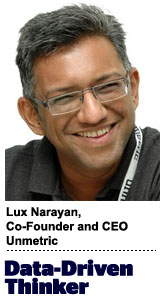 “Data-Driven Thinking” is written by members of the media community and contains fresh ideas on the digital revolution in media.
“Data-Driven Thinking” is written by members of the media community and contains fresh ideas on the digital revolution in media.
Today’s column is written by Lux Narayan, co-founder and CEO at Unmetric.
Data is often likened to oil, but the similarities go deeper than you might think. The first oil drills in North America were accidental. The oil emerged from the ground as prospectors sought their real prize: salt brine.
Similarly, it’s easy for marketers today to have the same mindset and view data that pours forth from their various campaigns as useful for reporting purposes, but after years of many evangelizing its importance, many advertisers still don’t employ data to inform their creative campaigns.
A recent McKinsey report deemed that a mistake. CMOs who use data to inform creativity double their revenue growth, according to the report. The difference was attitudinal; many CMOs saw creativity as independent of data collection.
Holding onto that belief is not only bad for business, it’s wrong. Smart marketers have always used data – whether gleaned from focus groups or a close reading of sales – as the foundation for their campaigns. They’re doing the same today, only with better data.
The link between data and creativity
Creativity is a mysterious process. But creativity in the context of marketing is a bit different: It is creativity in service of solving a problem.
For Kraft Foods, the problem was reaching parents with a message they hadn’t heard before. Kraft’s own research showed that 80% of parents feel pressure to be perfect and 80% of kids want parents who are great rather than perfect. This insight informed “Family Greatly,” a Dove Real Beauty Sketches-like campaign that contrasts parents’ perceived pressures with the more forgiving way their children view them.
Meanwhile, the hit #LikeAGirl campaign from Procter & Gamble’s Always brand originated from data showing 49% of girls felt paralyzed by the fear of failure.
Activia’s “It’s Starts Inside” effort was based on research showing that 80% of women 25-55 years old thought they were their own worst critics.
In each of these successful campaigns, the data wasn’t put through a machine that created the work. It was filtered through a human lens. The combination of both is what made the campaigns successful.
An increased need for content and communications
Another compelling argument for using data to inform creative campaigns is that it provides a steady stream of insights. Thanks to social media and the 24/7 nature of advertising in 2018, brands are creating more content than ever. The top 100 brands upload a new video to YouTube every 18.5 minutes.
Happily, the amount of accessible data has also risen, offering more relevant launch points for campaigns.
The need for greater prolificacy also dovetails nicely with the growth of machine learning and the addition of real-world A/B testing. Both ensure that marketers can focus less on grunt work and more on creativity. In this vision, machines can (and do) come up with thousands of iterations of a message and test them to see which ones hit their marks.
Alternating these types of efforts with big-idea campaigns conceived by human minds offers a promising way forward for advertisers looking to meet the demands of the market.
Data vs. creativity is a false dichotomy
The ad industry over the past few years has been embroiled in a pointless debate about the virtues of using data to fuel creativity. A staunch opponents of the practice is ad legend John Hegarty, who has argued that data can’t create an emotional bond with the consumer.
Of course it can’t, but it can help marketers create such bonds by getting a better idea of what consumers are thinking about and what moves them. This is the real “oil” that moves the markets these days. All the rest is salt brine.
Follow Lux Narayan (@LuxNarayan), Unmetric (@unmetric) and AdExchanger (@AdExchanger) on Twitter.
This post was syndicated from Ad Exchanger.


More Stories
Buyers Are Wasting Money on Alt IDs While Cookies Still Persist
Ibotta Crosses The IPO Finish Line – Now The Real Work Begins
Commerce Can No Longer Be Where Creative Goes to Die